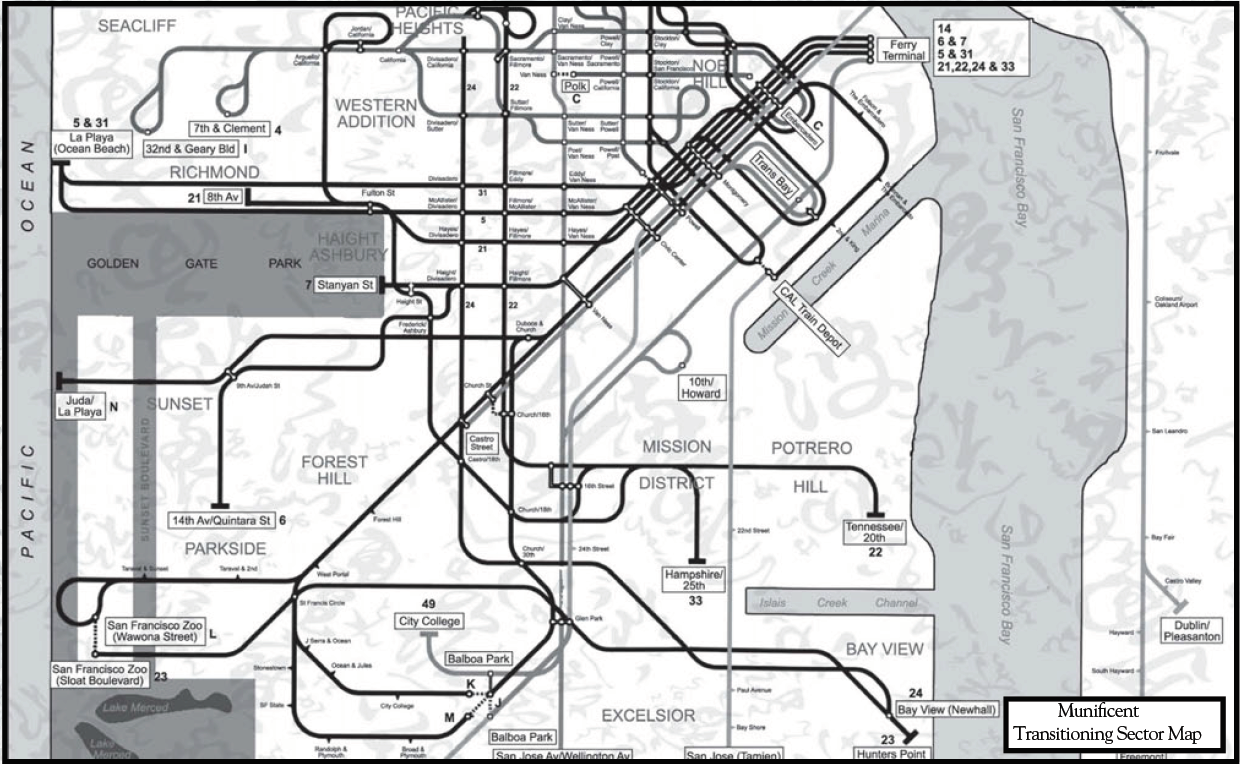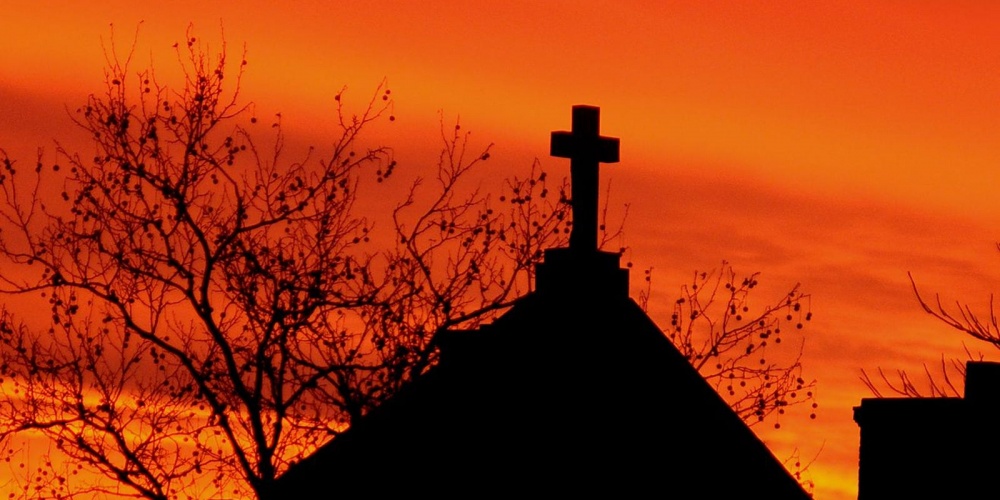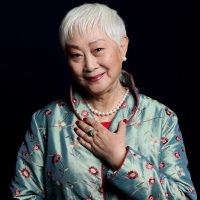Difference between revisions of "San Francisco"
(→Black Bart, the Plundering PO8) |
(→Barony of the Bridge) |
||
| Line 1,122: | Line 1,122: | ||
=== <span style="color:#A52A2A;"> Barony of the Bridge === | === <span style="color:#A52A2A;"> Barony of the Bridge === | ||
| − | :*[[Tristram]] - Baron of the Bridge | + | :*[[]] -- [[Tristram]] - Baron of the Bridge |
:*[[File:Alpin.jpg|200px]] -- [[Alpin]] - Tristram's second | :*[[File:Alpin.jpg|200px]] -- [[Alpin]] - Tristram's second | ||
---- | ---- | ||
Revision as of 15:27, 5 September 2020
Contents
- 1 Quote
- 2 Appearance
- 3 City Device
- 4 Climate
- 5 Demonym
- 6 Economy
- 7 Geography
- 8 History
- 9 Population
- 10 Arenas
- 11 Attractions
- 12 Bars and Clubs
- 13 Cemeteries
- 14 City Government
- 15 Crime
- 16 Citizens of the City
- 17 Current Events
- 18 Fortifications
- 19 Galleries
- 20 Holy Ground
- 21 Hospitals
- 22 Hotels & Hostels
- 23 Landmarks
- 24 Maps
- 25 Mass Media
- 26 Missives
- 27 Monuments
- 28 Museums
- 29 Newspapers
- 30 Parks
- 31 Private Residences
- 32 Restaurants
- 33 Ruins
- 34 Schools
- 35 Shopping
- 36 Telecommunications
- 37 Theaters
- 38 Transportation
- 39 Mages
- 40 Vampires of the City
- 41 Kuei-jin
- 42 Deceased or Missing
- 43 The Baronies: Undead Territories
- 44 Coteries of San Francisco
- 45 Websites
- 46 Errata
Quote
"San Francisco is 49 square miles surrounded by reality." -- Paul Kantner of Jefferson Starship
"May you live in interesting times." — Chinese curse
Appearance
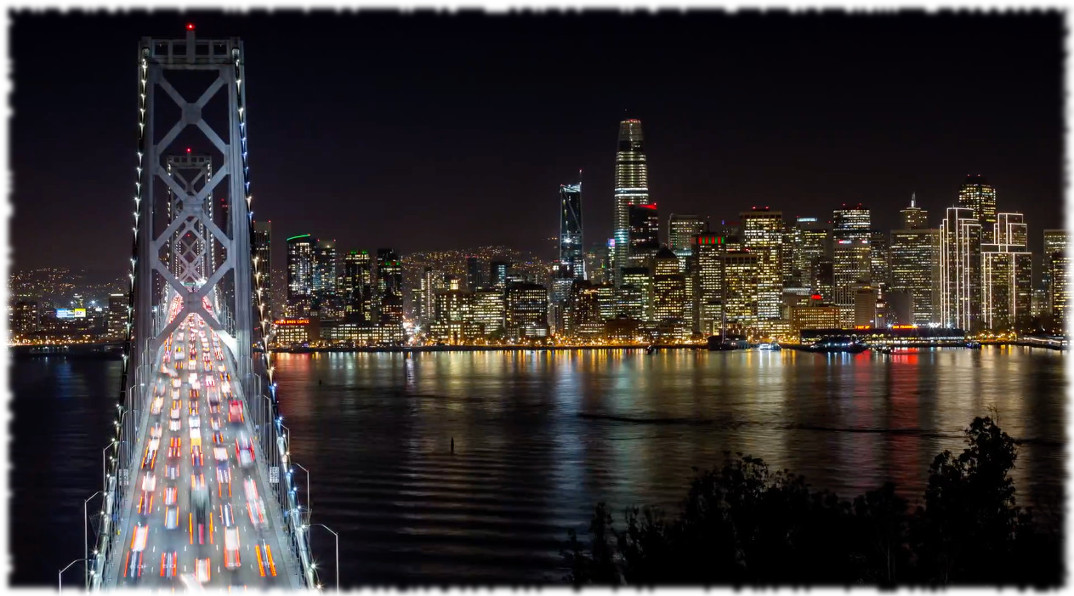
"No city invites the heart to come to life as San Francisco does. Arrival in San Francisco is an experience in living." -- William Saroyan, Armenian-American novelist
City Device
Climate
San Francisco has a warm-summer Mediterranean climate (Köppen Csb) characteristic of California's coast, with moist mild winters and dry summers. San Francisco's weather is strongly influenced by the cool currents of the Pacific Ocean on the west side of the city, and the water of San Francisco Bay to the north and east. This moderates temperature swings and produces a remarkably mild year-round climate with little seasonal temperature variation.
Fog is a regular feature of San Francisco summers.
Among major U.S. cities, San Francisco has the coolest daily mean, maximum, and minimum temperatures for June, July, and August. During the summer, rising hot air in California's interior valleys creates a low pressure area that draws winds from the North Pacific High through the Golden Gate, which creates the city's characteristic cool winds and fog. The fog is less pronounced in eastern neighborhoods and during the late summer and early fall. As a result, the year's warmest month, on average, is September, and on average, October is warmer than July, especially in daytime.
Because of its sharp topography and maritime influences, San Francisco exhibits a multitude of distinct microclimates. The high hills in the geographic center of the city are responsible for a 20% variance in annual rainfall between different parts of the city. They also protect neighborhoods directly to their east from the foggy and sometimes very cold and windy conditions experienced in the Sunset District; for those who live on the eastern side of the city, San Francisco is sunnier, with an average of 260 clear days, and only 105 cloudy days per year.
Temperatures reach or exceed 80 °F (27 °C) on an average of only 21 and 23 days a year at downtown and San Francisco International Airport (SFO), respectively.[96] The dry period of May to October is mild to warm, with the normal monthly mean temperature peaking in September at 62.7 °F (17.1 °C). The rainy period of November to April is slightly cooler, with the normal monthly mean temperature reaching its lowest in January at 51.3 °F (10.7 °C). On average, there are 73 rainy days a year, and annual precipitation averages 23.65 inches (601 mm). Variation in precipitation from year to year is high. Above average rain years are often associated with warm El Niño conditions in the Pacific while dry years often occur in cold water La Niña periods. In 2013 (a "La Niña" year), a record low 5.59 in (142 mm) of rainfall was recorded at downtown San Francisco, where records have been kept since 1849. Snowfall in the city is very rare, with only 10 measurable accumulations recorded since 1852, most recently in 1976 when up to 5 inches (130 mm) fell on Twin Peaks.
Demonym
Economy
Geography
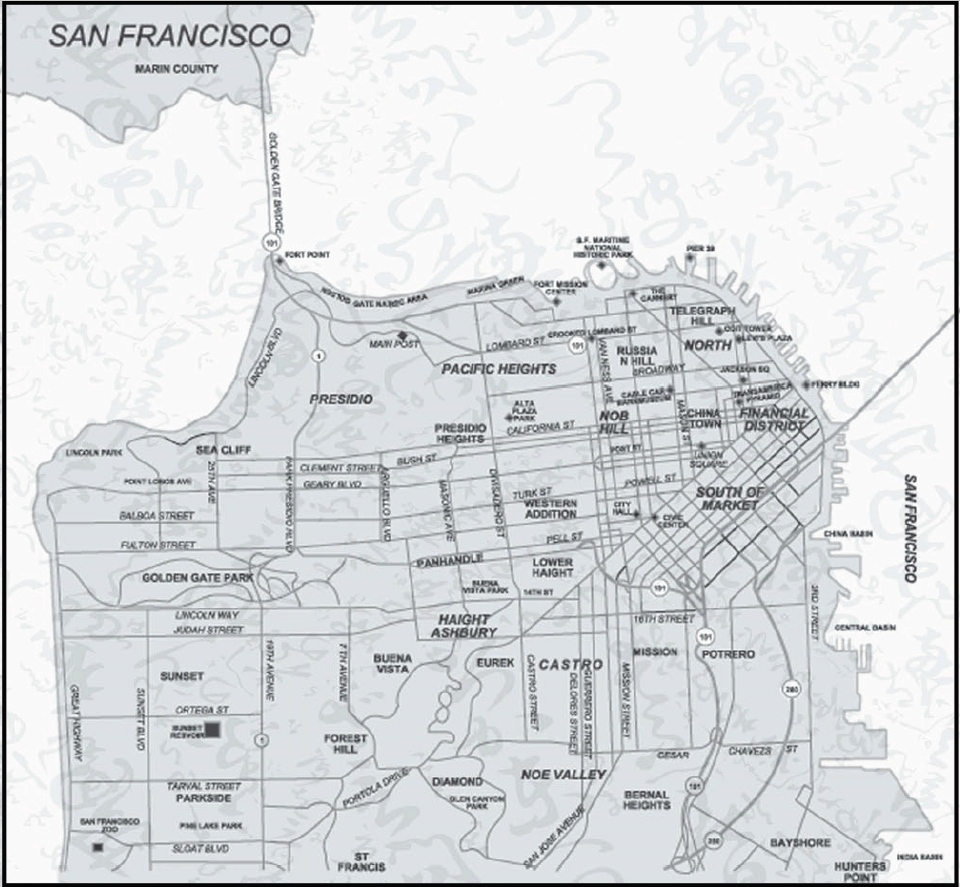
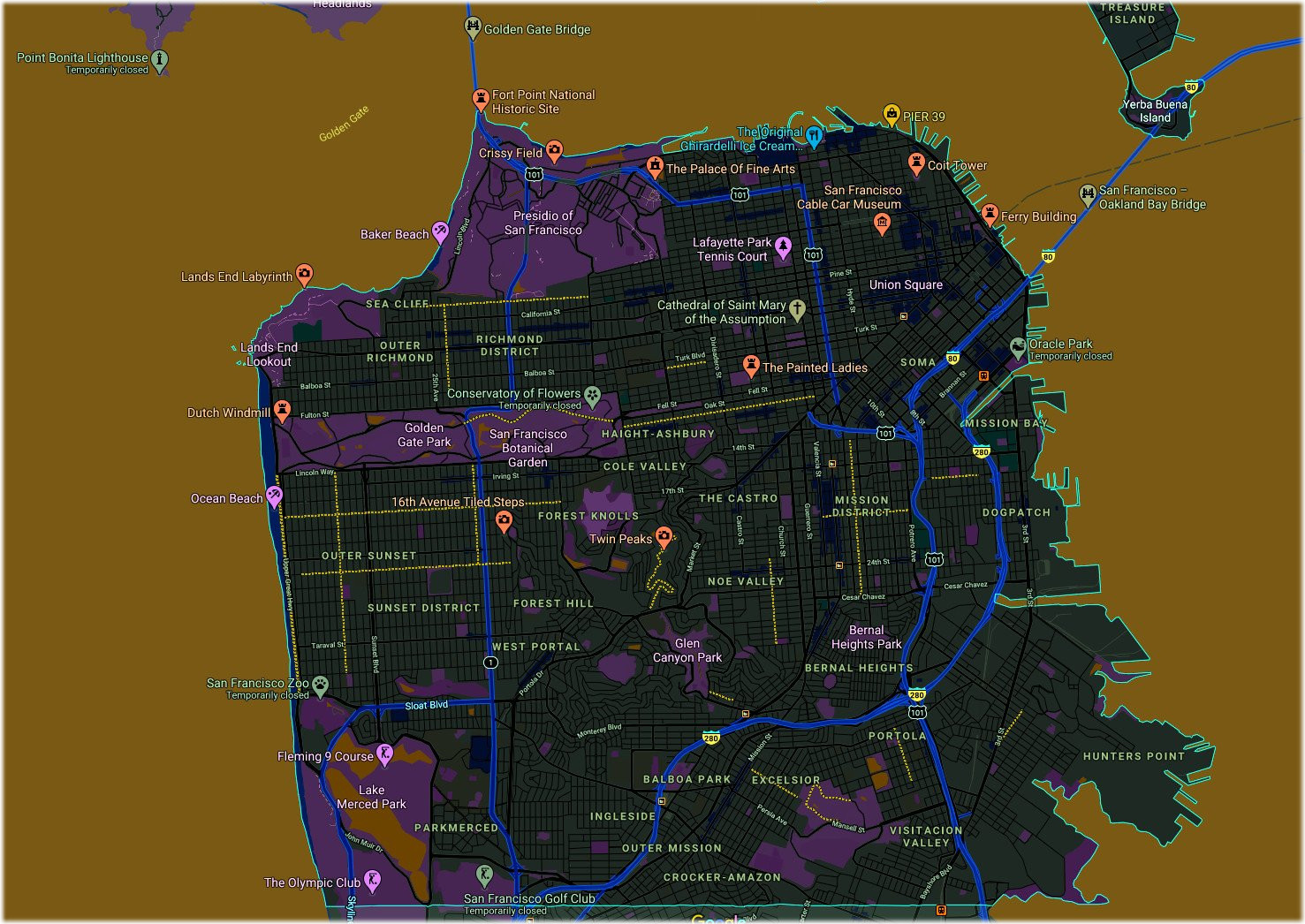
Whoever after due and proper warning shall be heard to utter the abominable word "Frisco",
which has no linguistic or other warrant, shall be deemed guilty of High Misdemeanour, and
shall pay into the Imperial Treasury as penalty the sum of twenty-five dollars. -- Emperor Norton
San Francisco is located on the West Coast of the United States at the north end of the San Francisco Peninsula and includes significant stretches of the Pacific Ocean and San Francisco Bay within its boundaries. Several picturesque islands—Alcatraz, Treasure Island and the adjacent Yerba Buena Island, and small portions of Alameda Island, Red Rock Island, and Angel Island—are part of the city. Also included are the uninhabited Farallon Islands, 27 miles (43 km) offshore in the Pacific Ocean. The mainland within the city limits roughly forms a "seven-by-seven-mile square", a common local colloquialism referring to the city's shape, though its total area, including water, is nearly 232 square miles (600 km2).
There are more than 50 hills within the city limits. Some neighborhoods are named after the hill on which they are situated, including Nob Hill, Potrero Hill, and Russian Hill. Near the geographic center of the city, southwest of the downtown area, are a series of less densely populated hills. Twin Peaks, a pair of hills forming one of the city's highest points, forms an overlook spot. San Francisco's tallest hill, Mount Davidson, is 928 feet (283 m) high and is capped with a 103-foot (31 m) tall cross built in 1934. Dominating this area is Sutro Tower, a large red and white radio and television transmission tower.
The nearby San Andreas and Hayward Faults are responsible for much earthquake activity, although neither physically passes through the city itself. The San Andreas Fault caused the earthquakes in 1906 and 1989. Minor earthquakes occur on a regular basis. The threat of major earthquakes plays a large role in the city's infrastructure development. The city constructed an auxiliary water supply system and has repeatedly upgraded its building codes, requiring retrofits for older buildings and higher engineering standards for new construction. However, there are still thousands of smaller buildings that remain vulnerable to quake damage. USGS has released the California earthquake forecast which models earthquake occurrence in California.
San Francisco's shoreline has grown beyond its natural limits. Entire neighborhoods such as the Marina, Mission Bay, and Hunters Point, as well as large sections of the Embarcadero, sit on areas of landfill. Treasure Island was constructed from material dredged from the bay as well as material resulting from the excavation of the Yerba Buena Tunnel through Yerba Buena Island during the construction of the Bay Bridge. Such land tends to be unstable during earthquakes. The resulting soil liquefaction causes extensive damage to property built upon it, as was evidenced in the Marina district during the 1989 Loma Prieta earthquake. Most of the city's natural watercourses, such as Islais Creek and Mission Creek, have been culverted and built over, although the Public Utilities Commission is studying proposals to daylight or restore some creeks.
Neighborhoods
The historic center of San Francisco is the northeast quadrant of the city anchored by Market Street and the waterfront. It is here that the Financial District is centered, with Union Square, the principal shopping and hotel district, and the Tenderloin nearby. Cable cars carry riders up steep inclines to the summit of Nob Hill, once the home of the city's business tycoons, and down to the waterfront tourist attractions of Fisherman's Wharf, and Pier 39, where many restaurants feature Dungeness crab from a still-active fishing industry. Also in this quadrant are Russian Hill, a residential neighborhood with the famously crooked Lombard Street; North Beach, the city's Little Italy and the former center of the Beat Generation; and Telegraph Hill, which features Coit Tower. Abutting Russian Hill and North Beach is San Francisco's Chinatown, the oldest Chinatown in North America.[88][89][90][91] The South of Market, which was once San Francisco's industrial core, has seen significant redevelopment following the construction of Oracle Park and an infusion of startup companies. New skyscrapers, live-work lofts, and condominiums dot the area. Further development is taking place just to the south in Mission Bay area, a former railroad yard, which now has a second campus of the University of California, San Francisco and Chase Center, which opened in 2019 as the new home of the Golden State Warriors.
West of downtown, across Van Ness Avenue, lies the large Western Addition neighborhood, which became established with a large African American population after World War II. The Western Addition is usually divided into smaller neighborhoods including Hayes Valley, the Fillmore, and Japantown, which was once the largest Japantown in North America but suffered when its Japanese American residents were forcibly removed and interned during World War II. The Western Addition survived the 1906 earthquake with its Victorians largely intact, including the famous "Painted Ladies", standing alongside Alamo Square. To the south, near the geographic center of the city is Haight-Ashbury, famously associated with 1960s hippie culture. The Haight is now home to some expensive boutiques and a few controversial chain stores, although it still retains some bohemian character.
North of the Western Addition is Pacific Heights, an affluent neighborhood that features the homes built by wealthy San Franciscans in the wake of the 1906 earthquake. Directly north of Pacific Heights facing the waterfront is the Marina, a neighborhood popular with young professionals that was largely built on reclaimed land from the Bay.
In the south-east quadrant of the city is the Mission District—populated in the 19th century by Californios and working-class immigrants from Germany, Ireland, Italy, and Scandinavia. In the 1910s, a wave of Central American immigrants settled in the Mission and, in the 1950s, immigrants from Mexico began to predominate. In recent years, gentrification has changed the demographics of parts of the Mission from Latino, to twenty-something professionals. Noe Valley to the southwest and Bernal Heights to the south are both increasingly popular among young families with children. East of the Mission is the Potrero Hill neighborhood, a mostly residential neighborhood that features sweeping views of downtown San Francisco. West of the Mission, the area historically known as Eureka Valley, now popularly called the Castro, was once a working-class Scandinavian and Irish area. It has become North America's first gay village, and is now the center of gay life in the city. Located near the city's southern border, the Excelsior District is one of the most ethnically diverse neighborhoods in San Francisco. The predominantly African American Bayview-Hunters Point in the far southeast corner of the city is one of the poorest neighborhoods and suffers from a high rate of crime, though the area has been the focus of several revitalizing and controversial urban renewal projects.
The construction of the Twin Peaks Tunnel in 1918 connected southwest neighborhoods to downtown via streetcar, hastening the development of West Portal, and nearby affluent Forest Hill and St. Francis Wood. Further west, stretching all the way to the Pacific Ocean and north to Golden Gate Park lies the vast Sunset District, a large middle class area with a predominantly Asian population.[98] The northwestern quadrant of the city contains the Richmond, also a mostly middle-class neighborhood north of Golden Gate Park, home to immigrants from other parts of Asia as well as many Russian and Ukrainian immigrants. Together, these areas are known as The Avenues. These two districts are each sometimes further divided into two regions: the Outer Richmond and Outer Sunset can refer to the more western portions of their respective district and the Inner Richmond and Inner Sunset can refer to the more eastern portions.
Many piers remained derelict for years until the demolition of the Embarcadero Freeway reopened the downtown waterfront, allowing for redevelopment. The centerpiece of the port, the Ferry Building, while still receiving commuter ferry traffic, has been restored and redeveloped as a gourmet marketplace.
Districts
Richmond
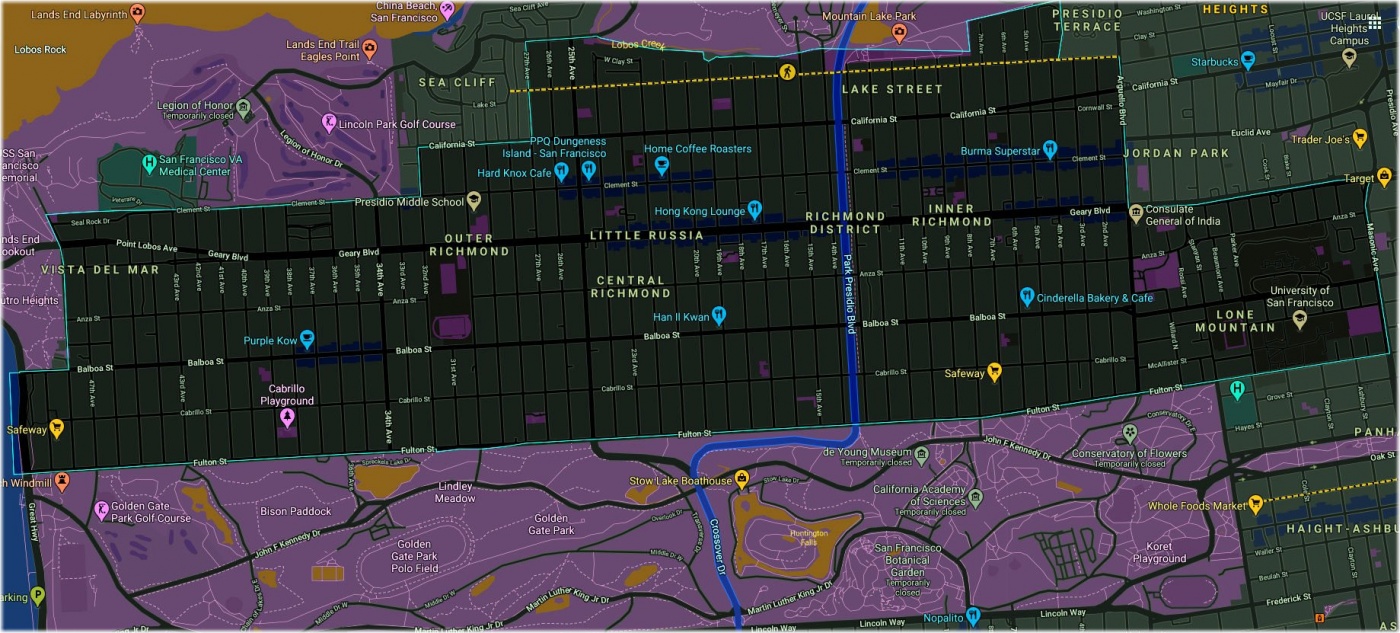
The Richmond District is a neighborhood in the northwest corner of San Francisco, California, developed initially in the late 19th century. It is sometimes confused with the city of Richmond, which is 20 miles (32 km) northeast of San Francisco.
The Richmond is in many ways defined by its relation to the parks; bordered by Golden Gate Park on the south, the Pacific Ocean to the west, and Lincoln Park, Land's End, Mountain Lake Park and the Presidio of San Francisco to the north, bisected by the Presidio Greenbelt.
The Richmond has many influences from the Chinese-American culture. One of its three commercial strips, Clement Street in the inner Richmond segment is sometimes called the second Chinatown due to the high concentration of Chinese establishments.
The other two commercial strips are Geary Boulevard and Balboa Street.
The Richmond also has deep Irish and Russian roots and has many Catholic and Orthodox churches.
Sub-districts
Sunset
Lakeshore
History
A rich and at times tragic history precedes the current state of affairs in San Francisco, though many of the vampires embroiled in the conflict are unaware of it (and perhaps doomed to repeat it). What both Kindred and Kuei-jin know is that history has picked up its pace in the Bay Area as well as the rest of the world for some time now. It is a pendulum racing on the downward swing , a prisoner of both gravity and momentum and subject to forces and paths not of its choosing. Aware of this, both sides fear there may be no stopping the events they set in motion within the city.
The Earliest Days
While San Francisco’s history only covers a two- century span, the history of the Bay area extends back much farther than that. Native American tribes like the Ohlone and the Miwok inhabited the region long before the arrival of the first Europeans or Asians landed on the shores of North America. These people knew nothing of t he Curse of Caine or the Fall of the Wan Xian, although they understood the creatures haunting the world’s dark and wild places. For the most part, the tribes remained small, warding off undue attention from their preternatural predators. They lived in relative peace with the Changing Folk of the wilds, never dreaming their fellow mortals from across the Atlantic would prove the greatest threat to their existence.
Exploration & Settlement
The first European visitors to curse the shores of California came in 1542, when Portuguese explorer Juan Rodriguez Cabrillo circumnavigated the tip of South America and sailed as far north as the Russian River, mapping the western coast of South and North America along his route. In 1579, famed English sailor Sir Francis Drake landed on California’ s northern coast, pausing briefly to claim the land for Queen Elizabeth before repairing his ships and setting sail once again. Sebastian Cermeno, another Portuguese explorer, “discovered” Punta de los Reyes (King’ s Point) in the 1590s. All the visiting Europeans missed the narrow entrance to San Francisco Bay, however, shrouded as it was by mist and nearly invisible from the sea. It would be centuries more before a European discovered the site of what would become the city of San Francisco.
In 1769, a Spanish soldier named Gaspar de Protola accidentally stumbled upon the bay’s entrance while sailing to Monterey Bay in the south. Six years later, Juan Ayala actually sailed into San Francisco Bay on a mapping expedition for the Spanish crown. It did not take the Spanish long to realize the value of their new discovery, given its strategic and economic potential.
In 1776, about a week before the thirteen English colonies on the other side of the continent declared their independence, Juan Bautista de Anza and some thirty Spanish-speaking families made their way from Sonora, Mexico to San Francisco Bay. They claimed the land for Spain and settled there. Their headquarters was an adobe fort they named the Presidio.
The settlers established a mission about a mile away from the fort. The priests officially named the mission Nuestra Senora de Dolores or Mission Delores, and dedicated the church to St. Francis of Assisi; it was known as “San Francisco,” the name later applied to the bay itself. The mission’ s priests took an interest in the spiritual welfare of the local Indian tribes, ensuring they were baptized and converted to Christianity; for the most part, the natives welcomed trade with the new settlers.
Independence & Growth
In 1821, Mexico won its independence from Spain, secularizing the Spanish missions and abandoning interest in the spiritual well being of the natives — or anyone else, for that matter. Freed from European rule, California’s ports opened for trade and shipped a wealth of goods (mostly hides, furs, wood and tallow) by sea around Cape Horn to the burgeoning factories in New England and New York. Trappers and hunters told tall tales about the strange beasts they encountered in the California hills, but few paid them any heed so long as the goods continued to flow.
The area’s growing prosperity was enough to convince English sailor William Richardson to jump ship in 1822 and settle there. He fell in love with the daughter of the Presidio’ s commandant and converted to Catholicism to marry her. He established a trading post that he named Yerba Buena (or “good herb”) for the wild mint growing in the area. The aptly chosen name later became a source of great humor to the people of San Francisco in the 1960s. Richardson’ s enterprise was wildly successful, and Yerba Buena grew from a trading post to a small town, with a saloon of ill repute frequented by English-speaking hunters and trappers.
Even though Yerba Buena and Mission Dolores grew, their population remained a few hundred at best, comprised of mostly farmers, trappers and a handful of soldiers stationed at the Presidio. During the war between the United States and Mexico in 1847, U.S. Marines from the warship Portsmouth seized the Presidio and the main plaza of Yerba Buena. The dozen or so Mexican soldiers at the Presidio surrendered without firing a single shot. Commander John Montgomery raised the U.S. flag and declared California an American territory. Among the first acts of the new territorial government was to change the settlement’s name to that of the bay: San Francisco.
Such small political victories were certainly of no interest to either the Kindred hunting in the nighttime streets of Boston, New York and Philadelphia, or to those sleeping by day in the mansions of Louisiana, Georgia or Carolina. The events in San Francisco were of even less interest to the Kuei-jin, who barely knew of California at all and remained far more concerned with the Opium Wars brought on by European (and Kindred) incursion into the Middle Kingdom. That, however, was about to change with a single word....
Gum San: The Golden Mountain
“Gold! Gold in the American River!” Mormon preacher Sam Brannan shouted that memorable statement while running through San Francisco’s streets in 1848. Although Brannan was a notorious charlatan, in this case he shouted the truth. Gold was found in the riverbed at a sawmill owned by Swiss-born John Augustus Sutter. Despite Sutter’s best efforts to keep the discovery quiet, the news spread like wildfire. Sam Brannan, incidentally, purchased large tracts of coastal land in San Francisco, as well as cornering the market on shovels, pickaxes and canned goods before making his fateful announcement. He became fabulously wealthy without turning over a single spade of dirt.
It seemed the world was primed for the news from San Francisco. The “Year of Revolutions” swept through Europe, with political and social unrest in many of her major cities. The Potato Famine stalked Ireland, driving people from their homes in hope of a new life elsewhere. The United States caught its breath following the war with Mexico while the conflicts leading to the Civil War simmered beneath the surface. China reeled from the Opium Wars and the abdication of Hong Kong to the British, while reforms swept through Japan. All this was dry tinder for the spark of hope ignited by the discovery of riches in California.
People from around the world flocked to San Francisco in droves. Ships departed from docks in Europe and America groaning from the weight of passengers and mining equipment. Ship-crews immediately deserted upon reaching California’s shores, leaving boats abandoned and turning Yerba Buena Cove into a “forest of masts.” Townspeople in America’ s heartland headed west in wagon trains, leaving behind empty homes and shops with signs in their windows reading, “GONE TO THE DIGGINGS.”
In 1849, San Francisco’s population soared from 900 to 26,000. Another 100,000 people drifted through the area on their way into the California hills and hinterlands in search of their fortune. San Francisco crushed the equivalent of fifty years of growth and development into the course of a single year.
The effects of San Francisco’ s sudden gold boom did not escape the Kindred. While their elders continued their affairs in Europe and the Eastern Seaboard, the promise of wealth and blood offered by an overcrowded boomtown drew young vampires from across the nation. Ambitious Camarilla neonates saw the potential to create domains of their own, away from the stifling grip of their elders. Meanwhile, Sabbat packs and anarchs anticipated a new, unspoiled frontier where they could do as they pleased. The Kindred certainly found opportunities in San Francisco, where the arrival of a ship laden with heavy crates was commonplace. In a place where so many new people intermingled, hardly anyone noticed one or two strangers among thousands... or cared if a few of those new arrivals mysteriously vanished.
Although there was no gold in San Francisco itself, it was the largest port community near the gold fields, making it the destination of choice for disembarking prospectors. Although a few of them actually found gold, most didn’t. Instead, most of the money in the area was made in a more traditional fashion. It didn’t take long for the locals to discover that it was far more profitable catering to the miners and prospectors than searching for gold themselves. Shops, saloons and all manner of businesses sprang up in San Francisco, looking to serve the needs of the burgeoning population.
The abandoned ships in Yerba Buena Cove were put to good use in helping the city grow. The city fathers handled the problem by hauling the ships up onto the shore, where they were either broken up and used to construct new buildings and furniture or simply turned into buildings themselves. Cut a door or two in the hull of an overturned ship and you had a saloon. Many such structures sprang up along the harbor.
In the shadows between these new buildings and in the tent cities of the newcomers, the Kindred hunted with near abandon. Prospectors in the San Francisco Bay area fell victim to accidents, the elements, starvation and despair. They committed suicide at the rate of over 1,000 a year. It was not uncommon to stumble across a dried-up corpse bearing a pickaxe and shovel in the hills; common enough, in fact, that inquiry into the deaths were unheard of. Nobody cared how the poor wretch died.
The hunting was plentiful and good, so much so that vampires all but ignored the traditional conflicts between Camarilla and Sabbat while glutting themselves on the bounty of blood. Naturally, vampires fought over certain watering holes, but the conflicts simply demonstrated how easily they fell to their baser needs. Kindred and Cainite were all too similar in their bestial tendencies — except when the Sabbat and Camarilla sects stepped in to enforce opinion and policy. Regardless of allegiance, however, all vampires quickly learned to confine their hunting to the new city. The Lupines stalked the wilds outside San Francisco as guards encircling a prison. They shredded the first vampires to stray into their domain as a warning to the rest.
A Land of New Promise
Of course, new arrivals to San Francisco came not only from Europe, Mexico and the United States, but also from the Middle Kingdom. China’s Opium Wars against England and the ongoing encroachment of gweilo — white barbarians — everywhere strained the situation in the Far East. To many Chinese, California was Gum San, the “Golden Mountain,” a land of promise and opportunity away from war and starvation. Around the time of the Gold Rush, the first ship laden with some three hundred Chinese arrived in San Francisco.
Unfortunately, these immigrants discovered their “golden land of promise” was a rough frontier following the Golden Rule: Those with the gold make the rules. The Chinese remained a close-knit community even after their arrival, laying the foundations for San Francisco’ s modern Chinatown. Rather than becoming prospectors and miners (though some of them did), many Chinese found employment either serving the needs of San Francisco’s more fortunate inhabitants or working for the powerful railroad companies, who sought cheap labor to complete the transcontinental railroad.
Of course, with the Chinese and other Middle Kingdom immigrants came the Wan Kuei, the Ten Thousand Demons. It was not that the August Courts had any interest in a frontier city in a barbaric land, but the presence of some Kuei-jin was inevitable. A few, disgraced in shadow wars or fallen from favor in the August Courts, chose self-imposed exile over facing the Eye of Heaven and Final Death. Some found the freedom of the frontier exhilarating while others suffered in silence, hoping to redeem themselves and return to civilization. There were also those mortals who crossed the ocean only to die in their new land, fight their way free of torture in Yomi and take the Second Breath. More experienced Kuei-jin usually dealt with the resulting chih-mei.
Regardless of their reasons for coming to the Golden Mountain, though, the Wan Kuei who made the ocean crossing quickly discovered they were not alone in San Francisco’s nights.
The Kanbujian
In Chinatown’s early years, the Kuei-jin learned that leaving the Middle Kingdom behind did not necessarily free a soul from the weight dragging it down to Yomi after death. On occasion, a mortal of Chinese descent would take the Second Breath outside the bounds of civilization and away from the watchful eyes of the Kuei-jin jina and elders. With no aid from others of their kind and no knowledge of their nature, most of these poor unfortunates succumbed to their Demons, becoming ravening flesh-eaters that the Kuei-jin were forced to hunt down and destroy. On rare occasions, the Kin-jin discovered one of these chih-mei and destroyed it as a threat to the Masquerade, unaware of what it really was or where it originated.
The Wan Kuei called these poor wretches kànbujiàn — “unable to see” — because they were blind to Dharma and the path to the Hundred Clouds. If found soon enough, they were often able to master their P’o nature and join Kuei-jin society; if they failed or were not found in time, the Wan Kuei “mercifully” gave them Final Death. What the Kuei-jin did not know at first — and later refused to acknowledge — was that some rare kànbujiàn mastered their Demon nature on their own. Most did so by surrendering to the Yama Kings and becoming akuma, but a few struggled to find their own way, even discovering some Dharma principles through trial and error. Their Way was flawed and fraught with peril, but their determination was great.
East Meets West
The first encounters between Kuei-jin and San Francisco’s Kindred were brief and fleeting. The Kindred quickly discovered the clannish Chinese immigrants were better left alone. While most Europeans and Americans had abandoned such “childish” notions as vampires, the Chinese still maintained their old ways. The Kindred were surprised that Asians knew enough to take precautions against creatures of the night. Some of them — paper charms, rice scattered across thresholds and the like — were laughable. Others, such as prayer beads, charms backed by a true and abiding faith or the simple wisdom to huddle close to the light in groups, made the Chinese more difficult prey.
Of course, most Kindred created excuses not to bother rather than admit difficulty. “Chinese blood is thin and not as satisfying,” some said. “They’re not as vigorous, and less lively than other mortals.” “It’s a small loss, since there is so much already available.” Still, it vexed some Kindred to be denied anything. Some accepted the challenge by hunting more “interesting” prey in Chinatown... only to vanish and never be seen again.
Rumors circulated among the city’s vampires. They said the Chinese knew far more than they let on, luring Kindred into some kind of trap. Another whisper claimed that their numbers included mysterious magi or vampire- hunters. Yet others said that they had forged a pact with the Lupines, or they were host to a hitherto-unknown clan of Cainites . This last fiction was the closest to the truth.
The Wan Kuei needed the Chinese community to build Scarlet Screens in this new and alien land. To protect their interests, they destroyed any threat to Chinatown. In the process, the Demon People learned more about the White Demons dwelling among the Western mortals, the ones who came with the gweilo to the Middle Kingdom.
The first thing the Kuei-jin realized was that the Westerners were too numerous; they were too few to risk open confrontations. So the Wan Kuei remained in Chinatown’ s shadows and kept to their own affairs and council. They gave the gweilo vampires good reason to avoid their domain, but did not venture too far outside of it either. Those who disobeyed or threatened this version of the Kindred’ s Masquerade paid with their unlives.
Shadow Plays
Lawlessness ruled San Francisco’s streets in the years immediately following the Gold Rush. The population surge overtaxed the city’ s limited law enforcement, and bribery helped ensure the law looked the other way for almost anything. Along the waterfront rested saloons and whorehouses where miners spent their money, with roving gangs of criminals more than willing to help lighten their pockets.
One of the most notorious gangs was the Sydney Ducks, comprised of criminals who had escaped exile in Australia and made their way to California. They would waylay passers-by, throwing a bag over their heads and relieving them of their money and valuables (often leaving the victim dead or merely stunned with a strike from a sap or fist). The practice became known as “hooding” and the criminals who did it as “hoodlums.” The Australian gangsters also operated protection rackets in and along the Barbary Coast. The Sydney Ducks set fire to parts of the city five times for denying them tribute. It happened so often that Chinatown and Barbary Coast residents built exclusively with brick and stone rather than wood, so their homes and businesses would not burn so easily.
Some Kindred thought it too convenient that the depredations of the Sydney Ducks hurt businesses influenced by the Camarilla as well as burning out portions of Chinatown. Rumors claimed the gang was under the influence of a Sabbat pack or anarchs. Some even believed that its roster might have included vampires, though no proof of these conjectures ever manifested. The fires, however, did convince many local Kindred and Kuei-jin to find fireproof havens — a precaution that would prove vital a few decades later.
By the mid-1850s, miners had panned or mined out most of California’s surface gold, leaving only the deeper underground veins to be tapped. Those wise enough to invest their money carefully (including the Ventrue and other Camarilla vampires) funded large mining operations to dig out the gold that remained beyond the means and reach of individual miners. The continually expanding waterfront also became the mouth by which to feed the hungry factories of the East Coast and Europe. During that period, trading companies shipped every product workers could dig, drag, chop or tear from the mountains, fields and forests. The city became the premier center for commerce along the Pacific Ocean, finally drawing the attention of the elders and Princes that their childer had left behind years before. The unspoken truce between Camarilla, Sabbat and anarch vampires in San Francisco was over.
Of course, “peace” was a relative term. Kindred from all three factions struggled against each other previously, but mostly over territory and mortals. When the Transcontinental Railway became a reality, the Camarilla mentality reasserted itself. It was decided that San Francisco should be brought under the Camarilla’s aegis, to that ensure the Sabbat and anarchs would not control the city.
Public Vigilance
As usual, the Camarilla operated behind the scenes, using mortal proxies to carry out their plans. The Sabbat Cainites in 1850s San Francisco were wealthy and powerful. In very un-sect-like machinations, they influenced mortals — usually criminals — who in turn assumed positions of power locally during the Gold Rush and held them through graft, corruption and influence peddling. Ballot stuffing was practiced openly and an honest man’s vote counted for little. The common people , however, grew tired of this lawless state of affairs. Their desire to see justice was the Camarilla’s weapon against the Sabbat.
On June 9, 1851 in Sydney Cove, a man named John Jenkins simply walked into a merchant’s store, picked up the safe and walked away. He loaded the safe into a boat and calmly rowed out into the bay. Several of the merchant’s friends and associates pursued Jenkins and caught him easily, though he dumped the safe overboard. The public outcry was considerable.
Local citizens formed the Committee for Public Vigilance, which tried and executed Jenkins on its own authority. The Committee was very loosely organized at first, but its presence did give San Francisco’s criminals pause, at least for a short while. Jenkins’ boldness and the relative ease of his capture sent rumors among the Sabbat of a Camarilla plot, but local corruption ran deep. The Sabbat knew it would take more than a few outraged vigilantes to mobilize San Francisco’s citizens against its mortal power base.
It wasn’t long, however, before matters worsened. In 1855, there were nearly 500 murders in California but only 6 legal executions. Corrupt politicians maintained a tight hold on the government. Municipal spending was through the roof — much of it went into graft, bribes and embezzlement, lining the pockets of the city’s “civil servants.”
James King was a prominent San Francisco banker who had lost his fortune when local financial panic closed his bank. Outspoken against local corruption, he used his remaining money and the encouragement of his friends to found a newspaper voicing his opinions. In October of 1855, King began publication of the Evening Bulletin, a four-page paper. In it, he denounced criminals and political figures alike in fearless editorials that had people all over the city talking.
When notorious gambler Charles Cora shot and killed U.S. Marshal Richardson, he was “formally arrested” by friends of his who held public office. It was considered likely that he would walk away a free man. Following the incident, King ran an editorial saying that that if Cora wasn’t hanged, Sheriff David Scannell should take his place on the gallows.
King also took on city supervisor James Casey, revealing that Casey was a felon who had served time in Sing-Sing Prison in New York. In retribution, Casey shot King outside the Bulletin office on Montgomery Street. Witnesses rushed the wounded reporter to a doctor while Casey’s cronies in law-enforcement “took him into custody.”
In response to the shooting, over a thousand people turned out at the Montgomery Block in a show of support for James King. The crowd later made its way to the Plaza, where word circulated that the Committee for Public Vigilance was reforming. The following morning, members of the 1851 Committee met and created a new, more organized group. They penned an oath of fealty and assigned each member a number by which he would be known within the organization, to maintain anonymity. A few days later, the Committee consisted of some 3,500 members. In the meantime, however, James King died from his gunshot wound at home.
The Committee for Public Vigilance marched on the jail guarded by hundreds of local militia and law officers loyal to James Casey. Using a cannon to batter down the door, the Committee took Casey with little protest from his protectors. They also took gambler Charles Cora into custody. Both men received advocates and stood trial before a jury of Committee members, who summarily convicted the two men and sentenced them to a public hanging. An immense crowd filled Sacramento Street to watch the double execution, cementing the Committee for Public Vigilance’s power in the minds of San Franciscans.
Meanwhile, the Camarilla encouraged the Committee’s vigilantes to attack the Sabbat’s mortal proxies in the name of justice. They eliminated many of the Sabbat’s pawns from positions of power. The so-called revolution also hid the nightly movement of Camarilla scourges eliminating Sabbat targets and consigning vampires to ash. As far as the Camarilla was concerned, the strikes were clean and precise. They believed that they were the cause of the Sabbat’s fall in San Francisco. What they did not realize was the extent of the Sabbat’s internal dissent and scattered resources. The Sabbat were defeated as much by their own lack of foresight as the Camarilla’s attacks.
After the Committee’s cleanup of the city’s political echelons, legitimate businesses thrived — with the Camarilla riding their coattails. San Francisco formally incorporated as a city of some 30,000 people. The City by the Bay became reality, and the Inner Circle recognized the rule of Prince Jebediah Hawthorne in the Domain of San Francisco.
Emperor Norton
"At the preemptory request of a large majority of the citizens of these United States, I Joshua Norton, formerly of Algoa Bay, Cape of Good Hope, and now for the last nine years and ten months past of San Francisco, California, declare and proclaim myself the Emperor of These United States." — Joshua Norton, September 19, 1859
The first and only Emperor of the United States was born in London, England in 1819. He arrived in San Francisco by way of South Africa at the age of 30, with the sum of $40,000 to his name. Within five years, he’d lost that considerable fortune by speculating in real estate and attempting to corner the local market on rice. Living in poverty, Norton wrote a proclamation declaring himself Emperor of the United States. It was published in a local newspaper, at least in part due to the sheer novelty of the idea. He wore a uniform that he obtained from a second-hand store and walked the streets, administering to the daily needs of his “ domain.”
Emperor Norton issued various proclamations during his “reign,” including the abolition of the Democratic and Republican parties and a decree against using “the abominable word ‘Frisco,’ which has no linguistic or other warrant.” That alone carried a $25.00 fine. He also proposed the idea of a “League of Nations,” where the international community could settle its disputes (many years before the actual League of Nations signed its charter in San Francisco). He issued his own money, which he traded for legal tender; many stores came to accept Norton’ s currency as payment. He even mediated public disputes, defusing one anti-Chinese demonstration by quietly standing and reciting the Lord’s Prayer. His example shamed the demonstrators so greatly that they returned to their own affairs.
Idle speculation about Emperor Norton circulated among San Francisco’s Kindred. One account said he was the victim (or, perhaps, beneficiary) of Malkavian manipulation. Others suggested he was a puppet of one faction or another, or that he provided a useful spectacle for the mortal herd. Some even believed he was fey-touched. Whatever the case, vampires considered Norton inviolate because of his fame and public standing. He was left as a purely mortal phenomenon.
Norton died on January 8, 1880 on California Street. He was buried in the Masonic Cemetery, and his funeral procession ran two miles long. Between 10,000 and 30,000 people attended his funeral to bid farewell to America’ s first and only Emperor.
Paths of Iron
San Francisco continued to grow steadily through the next decade, remaining a key center of commerce for North America’ s entire West Coast. As gold mining dwindled, the discovery of the Comstock Silver Lode in Nevada sent a new infusion of wealth into San Francisco’s coffers. Many of the city’s most powerful mining magnates owned either the Nevada mines or the machines to properly drill them, setting up a continuous circle of wealth. The newfound prosperity further cemented the Camarilla’ s hold over the city, their only real victory of any substance in California. It was a bastion of influence amid a sea of Sabbat and anarch power.
San Francisco’s only limitation was its isolation from the rest of the United States. Out on the edge of the continent’s westernmost frontier, travel to and from the City by the Bay required East Coast ships to circumnavigate Cape Horn. The building of the Transcontinental Railroad in the 1860s rectified that problem by connecting the Pacific and Central rail lines.
Chinese immigrant workers did much of the hard labor required to extend the Pacific Line through the harsh Utah desert. This elicited jealousy from Caucasian workers, who grumbled that the Chinamen stole their jobs. The government responded by passing “coolie laws” that penalized the Chinese workers and made it hard for them to earn a living. It was only part of a prejudice against Chinese people that simmered and festered beneath the surface — occasionally erupting into accusations or even violence.
San Francisco’s Chinatown remained a city-within- a-city; people mostly kept to themselves, running their own schools and businesses and generally catering to the area’s inhabitants. In turn, the city government passed laws limiting “foreign” ownership of property. It also enacted laws taxing foreign (mainly Asian) workers more heavily, thus protecting jobs for “good Americans.” The situation suited Chinatown’s few Kuei-jin and shen, since it kept their havens secure from foreign devils and prevented expatriated Chinese from intermingling with local Westerners.
Black Bart, the Plundering PO8
One of the most notorious criminal figures of late 19th century San Francisco made his debut in August of 1877. The man who later became known as Black Bart stopped a Wells-Fargo stagecoach, leveled a double-barreled shotgun at the driver and uttered his famous command: “Throw down the box.” The driver surrendered the wooden strongbox, after which the robber allowed him to leave unharmed. The box turned up later, empty except for a poem scrawled on the back of a waybill:
“I’ve labored long and hard for bread —"
“For honor and for riches —"
“But on my corns too long you’ve tread,"
“You fine-haired sons of bitches."
It was signed: “Black Bart, the PO8.”
News of the mysterious Black Bart and his “po8try” spread quickly, though the robber himself remained out of sight for roughly a year afterward. When he finally resurfaced, he robbed another stagecoach, followed by several more. He always worked alone, apparently traveling on foot through the rough hills outside San Francisco. Wells- Fargo and the city placed a considerable reward of $800 on his head, but Black Bart remained at large.
Authorities didn’t capture Black Bart until 1883, when he was wounded in a stagecoach robbery. Although he escaped, he left his possessions behind. Investigators tracked him through the San Francisco laundry that cleaned his clothes, leading them to Charles Bolton, AKA “Black Bart.” Bolton confessed to the robbery, but the courts sentenced him to only six years in prison. He served a little over four.
At his release, reporters mobbed Bolton, looking to interview the infamous Black Bart. When asked if he planned to rob any more stagecoaches, he replied that he would not commit any further crimes. The questions continued, until one young reporter asked, ”One final question. Do you plan to write any more poetry?”
Bolton smiled and said, “Young man, didn’t you just hear me say I would commit no more crimes?”
Charles “Black Bart” Bolton left San Francisco heading south. He disappeared shortly thereafter and was never heard from again.
The Dragon Thrashes its Tail
"Fire has reclaimed to civilization and cleanliness the"
"Chinese ghetto, and no Chinatown will be permitted in the"
"borders of the city... it seems as though a divine wisdom"
"directed the range of the seismic horror and the range of the fire"
"god. Wisely, the worst was cleared away with the best."
— The Overland Monthly, 1906
On April 18, 1906 at 5:12 AM , Kuei-jin geomancers sensed a shift in the dragon-lines, a stirring of powerful forces — the Earth Dragon was restless, and a tremendous earthquake struck San Francisco in response . The quake itself lasted for less than a minute, but it toppled buildings and buckled streets. Broken gas mains and fallen lamps ignited fires that swept through the city.
The local fire department mobilized almost immediately, but the earthquake had ruptured all the water mains, leaving them to fight the fires with buckets instead of hoses. They retreated, hoping to contain the inferno and allow it to burn itself out. That, unfortunately, did not happen. The fires raged and spread, burning all of one day and into the next. They consumed some 28,000 buildings, including all of Chinatown.
Despite both the Kuei-jin’s and Kindred’s best precautions, the fires caught them all by surprise. A few vampires perished in the blaze, unable to flee without facing sunlight and frenzied by Rötschreck or wave soul. Retainers helped some Kindred escape from mansions on Nobility Hill, while other vampires sought refuge in the earth that had seemingly turned against the city. A handful remained underground for several nights, fearful of the heat they felt above their heads. The horror of being burned to kindling frightened one or two Kindred so greatly that they waited too long and sank into Torpor, where they lay to this night. Some sires tell their neonate progeny that on still nights, you can hear them, scratching at the underside of sidewalks and roads.
The U.S. Army Corps of Engineers finally created a firebreak by dynamiting entire city blocks in the western districts. The blaze lasted for three days, as did the quake’s aftershocks. When it was all over, reporter Jack London wrote in a newspaper dispatch, “the City of San Francisco is no more.” The city was devastated, with some 3,000 people dead, 225,000 injured, vast numbers homeless and $400 million in damage (valued in 1906).
San Francisco’s vampire enclaves were in great disarray. Worse yet, with the mortal survivors huddled together for protection and comfort, hunting and feeding became exceedingly difficult. Forced to pick on lone stragglers and looters, many vampires turned on one another for vitae, sect be damned. The following weeks endured nightly destructions, with the strongest eliminating the weak . During the inevitable reconstruction, however, the Camarilla sent scourges into San Francisco to halt the indiscriminate feeding and make examples of Kindred who committed diablerie. The scourges caught and destroyed three Kindred, including one member of the primogen, but any other culprits either fled the region or hid their crime expertly.
The surviving Kuei-jin suffered the loss of their havens as well, and they would have to struggle against gweilo opposition (both mortal and Kin-jin) to regain it. Bereft of their sanctuaries , they hid among the mortal refugees of Chinatown as best they could, taking advantage of the deaths caused by the disaster to conceal their own feeding.
Some heralded Chinatown’s destruction as a blessing of sorts, and publicly hoped it would not be rebuilt.
Chinese and Western businessmen, however, planned to turn Chinatown into a tourist attraction — a unique part of San Francisco’s heritage that would draw people from around the world. The plan received the quiet support of Chinatown’s shen, including Father Li T’ien.
The city could not ignore the potential for prestige and income. Even Kindred who bothered concerning themselves with the “Chinatown problem” believed a tourist-town would eliminate the barriers the Asian enclave presented before. What they did not know was that the Kuei-jin chose to sacrifice their previous security for the opportunity to hide in plain sight.
In some ways, the fire and reconstruction following the Great Quake benefited both Cainites and Kuei-jin. With decades of influence among the wealthiest and most powerful mortals, the vampires subtly directed the reconstruction to suit their own needs. The rebuilt mansions on Nob Hill and the new Chinatown’s maze-like urban topography took shape under the watchful eyes of the city’ s oldest residents, with few people the wiser. The destruction of so many important papers and public records in the fire facilitated the flood of forged identities and birth certificates. In fact, a new wave of Chinese citizens known as “paper sons” gained their citizenship through such fake documents, swelling the local Asian population. Vampires “reset the clock” and established new, “legitimate” identities that withstood official scrutiny. The earthquake was a setback, but it would not keep San Francisco down.
Of cardinal importance to the Kuei-jin was that the earthquake revealed the shifting dragon lines in and around San Francisco. The shaking of the Earth Dragon’s tail released reservoirs of Chi that the Demon People tapped for their own purposes. They ensured that the new Chinatown controlled one such Dragon Nest. This life- force filled an invigorated San Francisco, thinned the Wall between worlds and drew the attention of other shen as well, who migrated to the city over the years. The Kin-jin remained largely ignorant of the geomantic implications of the quake, as the Kuei-jin hoped. Let the barbarians play at their petty struggles... the Demon People controlled San Francisco’s true power.
Population
- -- City (883,305) - 2018
- -- Metro (4,729,484) - 2018
- -- CSA (9,666,055) - 2018
Arenas
Attractions
Bars and Clubs
- -- The Way Down -- A club known for its mixed supernatural clientèle.
- -- Laura - Waitress at the The Way down
- -- Dracula's Daughter -- A Kindred club that has admitted a number of other supernaturals.
- -- Gold Club -- High End Gentlemen's club
Cemeteries
- Star of the Sea Catholic Church
- Pastor Father Andrew
- John (Gravedigger and Handyman)
- Jacob (Gravedigger and Handyman)
- Star of the Sea Catholic Church
City Government
Crime
In 2011, 50 murders were reported, which is 6.1 per 100,000 people. There were about 134 rapes, 3,142 robberies, and about 2,139 assaults. There were about 4,469 burglaries, 25,100 thefts, and 4,210 motor vehicle thefts. The Tenderloin area has the highest crime rate in San Francisco: 70% of the city's violent crimes, and around one-fourth of the city's murders, occur in this neighborhood. The Tenderloin also sees high rates of drug abuse, gang violence, and prostitution. Another area with high crime rates is the Bayview-Hunters Point area. In the first six months of 2015 there were 25 murders compared to 14 in the first six months of 2014. However, the murder rate is still much lower than in past decades. That rate, though, did rise again by the close of 2016. According to the San Francisco Police Department, there were 59 murders in the city in 2016, an annual total that marked a 13.5% increase in the number of homicides (52) from 2015.
Gangs
Several street gangs operate in the city, including MS-13, the Sureños and Norteños in the Mission District,. African-American street gangs familiar in other cities, including the Crips, have struggled to establish footholds in San Francisco, while police and prosecutors have been accused of liberally labeling young African-American males as gang members. Criminal gangs with shotcallers in China, including Triad groups such as the Wo Hop To, have been reported active in San Francisco. In 1977, an ongoing rivalry between two Chinese gangs led to a shooting attack at the Golden Dragon restaurant in Chinatown, which left 5 people dead and 11 wounded. None of the victims in this attack were gang members. Five members of the Joe Boys gang were arrested and convicted of the crime. In 1990, a gang-related shooting killed one man and wounded six others outside a nightclub near Chinatown. In 1998, six teenagers were shot and wounded at the Chinese Playground; a 16-year-old boy was subsequently arrested.
Peace Officers
The San Francisco Police Department was founded in 1849.
The portions of Golden Gate National Recreation Area located within the city, including the Presidio and Ocean Beach, are patrolled by the United States Park Police.
The San Francisco Fire Department provides both fire suppression and emergency medical services to the city.
The city operates 22 public "pit stop" toilets.
Citizens of the City
Current Events
Fortifications
Galleries
Holy Ground
Hospitals
- Saint Francis Memorial Hospital
- Cynthia Spicer - High Security Terrorist attack survivor
- St. Mary's Medical Center (San Francisco) -- SMMC is the oldest continuously operating hospital in San Francisco.
Hotels & Hostels
Landmarks
- Alcatraz Island -- is home to the abandoned prison, the site of the oldest operating lighthouse on the West Coast of the United States, early military fortifications, and natural features such as rock pools and a seabird colony (mostly western gulls, cormorants, and egrets).
- Three Brother's Storage -- Owns several storage units inside office buildings in financial district
Maps
Mass Media
Missives
Monuments
Museums
Newspapers
- -- San Francisco Chronicle -- It is the only major daily paper covering the city and county of San Francisco. {Est. 1865}
Parks
Private Residences
Restaurants
Ruins
Schools
Shopping
- -- Doc's Comics & Collectables -- Owned by Dr. Diego "Doc" Soto, a PhD in both Criminal Justice and Civil War History, author of books on Alcatraz, comic book store owner, writer, and artist.
Telecommunications
Theaters
Transportation
Mages
- -- Penny Dreadful -- Born as Penelope Anne Drizkowski, is a mage and signature character of the Hollow Ones.
Vampires of the City
Brujah
 --Angelica White -- (PC)
--Angelica White -- (PC)
Gangrel
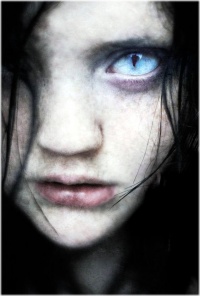 -- Esko -- Gangrel Elder
-- Esko -- Gangrel Elder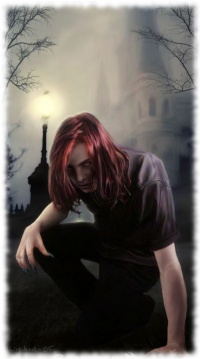 -- Logan Wakefield -- Gangrel wanderer (Former PC) <<Now in Torpor>>
-- Logan Wakefield -- Gangrel wanderer (Former PC) <<Now in Torpor>> -- Liborio Tosetti (PC) [Morgan]
-- Liborio Tosetti (PC) [Morgan] -- Nannette Logan's Child
-- Nannette Logan's Child
Malkavian
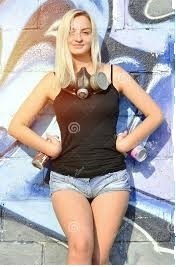 --Annabel Nolan -- (Former PC)
--Annabel Nolan -- (Former PC)
Toreador
 -- Lorraine - Owner of The Way Down club
-- Lorraine - Owner of The Way Down club -- Quon Corbyn - Teen Hacker
-- Quon Corbyn - Teen Hacker
Daughters of Cacophony
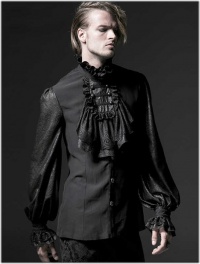 -- Everett Young -- Anarch Musician
-- Everett Young -- Anarch Musician
 -- Justine McDavid -- New Child of Everett Young
-- Justine McDavid -- New Child of Everett Young
Barony of the Sea
Baron Toc's Crew
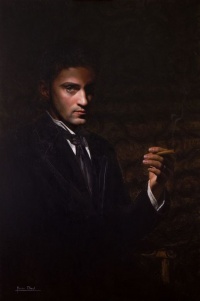 -- Sebastian Toc -- Brujah Leader
-- Sebastian Toc -- Brujah Leader- -- Katia -- Sebastian's Second
- -- Cord Brashen -- Sebastian's Muscle
- -- Bashe -- Toreador member of Sebastian's crew
- -- Alban -- Sebastian's Accountant
Barony of the Bridge
Kuei-jin
Jade Dragons
Golden Dragons
Deceased or Missing
- -- Sara Anne Winder -- Ventrue Duke of San Francisco. {missing}
- -- Vannevar Thomas -- Former Ventrue prince of the city, {deceased}
The Baronies: Undead Territories
Barony of the Bridge
Barony of the Sea
Barony of the Jade Dragons
Barony of Tok
Barony of the Golden Dragons
Places of Interest
- San Francisco State University -- San Francisco State University (commonly referred to as San Francisco State, SF State and SFSU) is a public university in San Francisco. As part of the 23-campus California State University system, the university offers 118 different bachelor's degrees, 94 master's degrees, and 5 doctoral degrees along with 26 teaching credentials among six academic colleges.
Coteries of San Francisco
- The New Crew -- An unofficial gang of neonates and fledglings that has recently sprung up.
Websites
---
---
https://environment.ambient-mixer.com/
---
---
https://washingtonmonthly.com/magazine/julyaugust-2012/the-power-broker/ {How politics really work in San Francisco}
---
https://en.wikipedia.org/wiki/Alcatraz_(TV_series)
---
---
---
https://www.onlyinyourstate.com/northern-california/san-francisco/abandoned-san-francisco/ {Abandoned San Francisco}
---
https://www.onlyinyourstate.com/author/sgarr/ {Visitor's guide to San Francisco}
---

